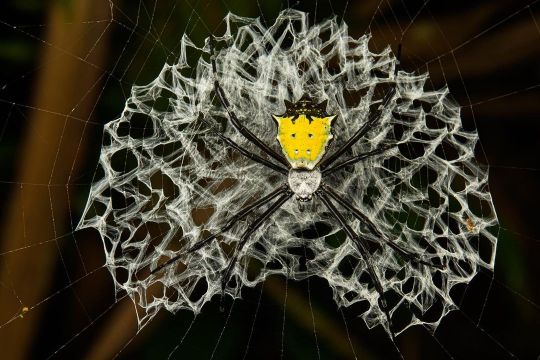#orbwebs
Explore tagged Tumblr posts
Text
Mayflies: making the most of a short life!

View On WordPress
0 notes
Text

In celebration of the orbweb spider outside my kitchen window, catching and demolishing a huhu beetle. She was guarding that thing all day, seemed so excited for it.
39 notes
·
View notes
Photo

A nice and yellow orb web spider (Argiope cf. submaronica) from Costa Rica, shot earlier this year while looking for frogs at @centromanu_cr #spider #argiope #arthropod #orbweb #costarica #puravida #spidersofinstagram @ilcp_photographers (at Centro Manú Costa Rica) https://www.instagram.com/p/Ck8s8zyKz3T/?igshid=NGJjMDIxMWI=
2 notes
·
View notes
Photo

aciniform #araneusdiadematus #photography #macro #macrophotography #arachnid #spiderweb #orbweaver #europeangardenspider #orbwebs #cannibal #postcoitalcannibalism #female #proteinfibre #spiderphotography #bokeh #dof #holartic #majorampullatesilk #spinnerets #pedipalps #aciniform #insectphotography #spiderphotography #nature #daqween https://www.instagram.com/p/B3ZvnDshe7V/?igshid=11n0kbpehugc1
#araneusdiadematus#photography#macro#macrophotography#arachnid#spiderweb#orbweaver#europeangardenspider#orbwebs#cannibal#postcoitalcannibalism#female#proteinfibre#spiderphotography#bokeh#dof#holartic#majorampullatesilk#spinnerets#pedipalps#aciniform#insectphotography#nature#daqween
0 notes
Video
An orb weaver spun a large and beautiful web between a bush and my car! It’s a good thing I had the flash(light) on my phone, because I would have walked right into it in the dark. Sadly, I had to ruin the web because I needed to actually use my car, but I made sure to relocate the spider to a safe location before doing so. #spider #orbweaver #orbweb #spiderweb https://www.instagram.com/p/B0fqbrvF8yB/?igshid=1rx4oksgvj3an
1 note
·
View note
Photo

Spider praying upon the dragonfly 網に白帯(はくたい)が目立つことからコガネグモであることがすぐに分かる。白帯の機能については諸説あるが、飛翔能力も視力も優れたトンボさえ囚われてしまうことから、獲物を誘引するとの説に賛成したい。従って、隠れ帯と呼ぶことはしない。 #Argiope_amoena #Argiope #spider #コガネグモ #webdecoration #stabilimentum #orbweb #spider #白帯(はくたい) #スタビリメンタム #Uloboridae #ウズグモ科 (総社緑地) https://www.instagram.com/p/CF32v6UgO76/?igshid=e3125y1lwlub
#argiope_amoena#argiope#spider#コガネグモ#webdecoration#stabilimentum#orbweb#白帯#スタビリメンタム#uloboridae#ウズグモ科
0 notes
Photo

#spider #spiderweb #orbweb https://www.instagram.com/p/CEkk_vBhFTiFj4OhLIh13zjlF84P9f20KN6r200/?igshid=1d1er2g1ol5zx
0 notes
Photo

#Repost @himalay_music • • • • • • 𝐀𝐫𝐠𝐢𝐨𝐩𝐞 𝐛𝐫𝐮𝐞𝐧𝐧𝐢𝐜𝐡𝐢 (𝐰𝐚𝐬𝐩 𝐬𝐩𝐢𝐝𝐞𝐫) Single zig-zag pattern of silk through it's centre (called a ‘stabilimentum’) is thought to reflect UV light and attract pollinating insects such as flies, bees and moths. @_ibab_official #argiope #argiopebruennichi #waspspider #arthopoda #arthopod_perfection #insectphotography #orbweb #orbweaverspider #bangalore #instagram #anthropologie #anthropology #mia3photography #xiaomiphotography #pixelcam https://www.instagram.com/p/CCIsOT3p-40/?igshid=1ll0senodzqn6
#repost#argiope#argiopebruennichi#waspspider#arthopoda#arthopod_perfection#insectphotography#orbweb#orbweaverspider#bangalore#instagram#anthropologie#anthropology#mia3photography#xiaomiphotography#pixelcam
0 notes
Photo

🕷Arañas de rayas blancas🕷 🕸Orchard Orb-weaver🕸 📚Genus Leucauge📚 . These beautiful spiders can be found in the tropics around the world, usually in riparian habitats (habitats between the land and a river or stream) of the rainforest above creeks or other bodies of water inside the forest. Sexual dimorphism is present in the species. 🌎🌍🌏 . You can distinguish them by their six black eyes in the front and their multicolor opisthosoma (their abdomen). 🍭6️⃣👁 . They build two types of nets, one as a barrier web, which has no patterns plus utilized for protection, and the main orb-web, which used to hunt their prey.🦋🐞🐛🦟🦗 . ➡️Reference: http://www.americanarachnology.org/JoA_free/JoA_v38_n3/arac-38-03-446.pdf . . . #spider #artopodos #forest #panama #pty #environment #naturaleza #animal #arthopods #science #orbweb #discover #wildlife #amazing #canon #macro #water #arachnid #rest #love #cool #photography #photo #bosque #rios #arañas #biologia #biology #onlynature 💚 (at Distrito de Chepo) https://www.instagram.com/p/B-TEs_eBxBs/?igshid=1fea9ph2kyuoi
#spider#artopodos#forest#panama#pty#environment#naturaleza#animal#arthopods#science#orbweb#discover#wildlife#amazing#canon#macro#water#arachnid#rest#love#cool#photography#photo#bosque#rios#arañas#biologia#biology#onlynature
0 notes
Note
a few months back there was a spider that lived in the crack between my wall and my floor (I have a very poorly made apartment) and he didn't weave any webs or anything he just sat there. I'm wondering if there are other spiders with that kind of behavior? it was really fascinating to me
There are a lot of spiders that don't make cobwebs or orbwebs, including huntsman spiders and jumping spiders. Instead of waiting for prey to come to them, they hunt actively.
49 notes
·
View notes
Photo

All these tiny little #orbwebs everywhere on the grass 😍
0 notes
Text
Have too many cherry tomatoes? Put them on inexpensive pizzas to spruce them up.

submitted by /u/orbweb [link] [comments]
from Gardening, Plants, and Agriculture. https://ift.tt/3lXpWMA
0 notes
Photo

Araneus diadematus #araneusdiadematus #photography #macro #macrophotography #arachnid #spiderweb #orbweaver #europeangardenspider #orbwebs #cannibal #postcoitalcannibalism #female #proteinfibre #spiderphotography #bokeh #dof #holartic #majorampullatesilk #spinnerets #pedipalps https://www.instagram.com/p/B1R--ZXBSZI/?igshid=1pls3u82uh7gh
#araneusdiadematus#photography#macro#macrophotography#arachnid#spiderweb#orbweaver#europeangardenspider#orbwebs#cannibal#postcoitalcannibalism#female#proteinfibre#spiderphotography#bokeh#dof#holartic#majorampullatesilk#spinnerets#pedipalps
0 notes
Text

Google lense says orbweb spider but it has been wrong before
Ok can anyone help me figure out wtf a bug is?
150 notes
·
View notes
Photo

Please excuse the terrible photo, I took this with my phone and as you can see from the detail on my hand, the spider was very small!
I’m pretty sure this is a female white micrathena orbweaver (Micrathena mitrata). I found it in my yard, at the center of an enormous orbweb that stretched several feet in every direction.
I’ve seen a ton of spiny and arrow-shaped micrathena on the ID-based subreddits I participate in, but never a white one. I’ve never spotted one IRL, either. Did not know much about them at all until I read the bugguide.net entry; their genus name apparently comes from the Greek adjective for ‘small’ and the name of the goddess Athena.
Good to see you, smol Athena!
1 note
·
View note
Photo

Custom piece I had recently finished and sent out, super happy with this treat and super stoked my customer is so pleased 😍🖤 #customorder #ratskull #skull #macabreart #macabre #beautyindecay #beautyindeath #bones #skulls #orbweb #orbwebweaver #spider #stilllife #curio #vultureculture #photooftheday #insectsofinstagram #artistsofinstagram #oddities #alternativedecor #insecttaxidermy #entomology #arachnid #arachnids #curioshop #healingcrystals (at Diss, Norfolk) https://www.instagram.com/p/BoHJwJ2HYZs/?utm_source=ig_tumblr_share&igshid=yfik5jd7jnvx
#customorder#ratskull#skull#macabreart#macabre#beautyindecay#beautyindeath#bones#skulls#orbweb#orbwebweaver#spider#stilllife#curio#vultureculture#photooftheday#insectsofinstagram#artistsofinstagram#oddities#alternativedecor#insecttaxidermy#entomology#arachnid#arachnids#curioshop#healingcrystals
0 notes